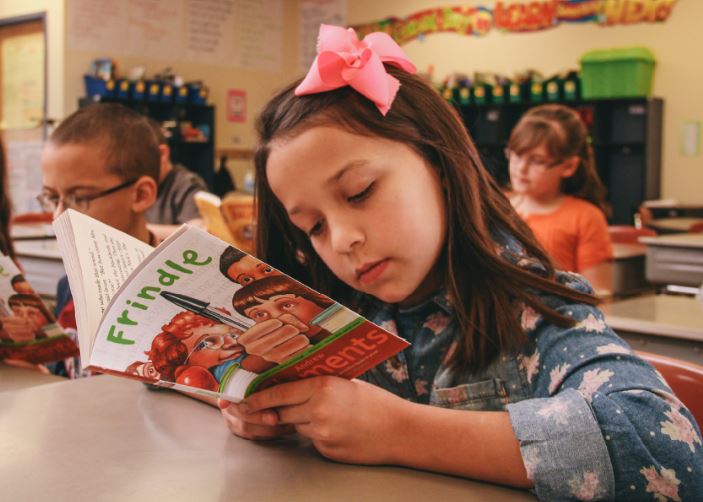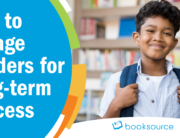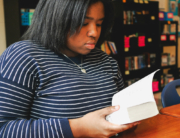I was able to work with Pam Allyn on a project a while back, and of the many wonderful things she said, one thing in particular stood out: Accountable independent reading is the heart of balanced literacy. There was something about the words “accountable” and “heart” that impacted me.
At first we might think of accountability as referring only to the students. We hear accountability every day, in every school, for every class, every year. Of course we want to hold students accountable for their reading, writing, discovering and learning. But in this case, it was the accountability of the teacher that struck me. While being the most important part of the day, a well-structured, well-planned and well-taught independent reading program is the easiest thing to blow off. Teachers are interrupted constantly. Whether it be a bloody nose, an assembly, a fire drill or teen drama, schedules are constantly readjusted throughout the week. And when this happens, we all know how those planning books look on Friday. With scratches, arrows, highlights and white-out tape, we just hope that nobody asks to see them. Cutting independent reading is easy. I get it. But that doesn’t make it right.
Independent reading is the heart of any literacy program and needs to be consistent day to day, week to week, month to month. It needs to be number one. When we are accountable for its value, the value transfers to the students. And our goal is for that value to transfer over to a lifelong love of reading.
Independent Reading: So Let’s Do It!
The research is there and it’s not new. “Because engaged readers spend 500% more time reading than disengaged readers, teachers should attempt to increase engaged reading time by 200%-500%” (Guthrie, 2004). But volume is not enough. K.J. Topping, J. Samuels and T. Paul studied data on over 45,000 students (The study is worth the read!). They found quantity paired with the quality of practice leads to high achievement in many areas (Topping, 2007). Reading a lot and receiving quality instructional strategies gets it done.
So how do we get it started? Quantity. Accountable independent reading. First we need the books, and while new books are a sensory wonder, sometimes we have to scrape.
When we know in our heart that we must have books, whether it’s in the budget or not, we have to find a way to get them. There is no other option. Even though the research shows the need for schools to purchase books is a necessity, sometimes we have to search for other methods to get our way. We need to argue the savings. More books means less copies and less disposable materials. They are reused year after year. We’ll find them used at garage sales. I invaded my little cousins’ books. We do everything we can to convince the person in charge of the budget that this is the most economically feasible material in the classroom.
Independent Reading Must Be Taught
The biggest criticism I’ve heard against independent reading is that students just don’t “do it.” I read an article in The New York Times a while ago from a teacher who said he “tried” independent reading, and he thought that even though it might work in affluent areas, there was no way his inner-city seventh-graders were learning anything. While admitting some problems were due to his inexperience as a teacher, he put most of the blame on the concept. He stated that the students couldn’t pick out a book, they weren’t really reading, and it was just basically a free period.
Let’s break that down. The first misconception mentioned is that students will just do what you ask them to do the first time you ask them to do it. They won’t.
You can’t expect students to pick up a book to read unless you teach them to pick up a book to read—especially those students who don’t have access to many books at home. That’s like expecting someone to throw a pot on the pottery wheel on the first day of art class. Are you not going to teach them how to choose and cut the clay? What the expectations are for cleanup? How they are to pull up the sides? How you set it out to dry? What about the glazing? Kneading? Adding water?
Independent reading is not simply about knowing how to read and actually reading a book. It is about expectations, routines, behaviors and choice.
All of this must be taught beginning the first day of school. And sometimes it takes a long time for a group to learn it. The dynamics of a class are different from year to year; students come to you with different interests, motivations and chemistry. Some groups get this independent reading routine after two weeks, others two months. But what I have validated year after year of 25 years in the classroom is that without a well-structured independent reading program, with rules, expectations and accountability, no other part of the balanced literacy map will fall into place, meaning no quality strategic instruction will occur. Time will be wasted over and over again without that time investment beginning on the first day of school.
What do they need to know? Assume everything. What do they already know? Assume nothing.
Before students get their hands in those shelves, give them an idea of what is on them. Read aloud—beginnings of books, endings of books, whole books, poems, facts from nonfiction books, anything. Model to them. How do you decide on a book? How do you know if it’s too hard or too easy? Where does the book go when you are finished? What happens if you don’t like a book? Can you abandon a book? What if you love a book? Can you read it again? And again?
Talk about the books, share the books and decide the answer to the many questions about the books—together. Create a community.
What are Your Independent Reading Routines?
It takes a lot of thinking on your part and anticipating to build independent reading routines. What fits in your comfort zone and with your personality? What school building rules must you keep in mind? What rules are nonnegotiable? Can students sit anywhere? Can they read aloud? Can they bring dolls or stuffed animals to read to? Can they partner read? Read in the halls?
When I taught independent reading, I always started off really tight and strict. But I told the students that I was doing that, and that eventually they would be able to read on the bean bag chairs or with a partner. Eventually, they could bring a toy to read to. Eventually they could go to the shelves whenever they wanted. Throughout my career, this has worked with all students, from teens to tots. And I always kept my word. Never promise what you can’t deliver.

I constantly praised on-task behavior and gently guided off-task behavior. My priorities were twofold: I needed to get them to love independent reading and I needed them to know it was the most important part of the day.
Another common fallacy about independent reading is that this time of the day is quiet and relaxing. Often teachers choose to put it at the end of the day because they consider it down time. In truth, accountable independent reading is not always quiet, especially with younger readers. They want to read aloud to their dolls, their stuffed animals, each other and you. And while most are resilient to the outside noise, some need a quiet space, without any distractions, and we absolutely need to provide that place. While it might be restful for students to read, especially later in the year when they are curled up on the rug reading their favorite story, it shouldn’t be a restful time for teachers. Conferring with each student is yet another form of accountability for you and your students.
As we teach independent reading on day one and throughout the following weeks, it’s important to remember to keep distractions present. Spend time walking around the room making casual conversation about the books they are reading and about the students themselves. Get to know them and what they like. Students need to be accustomed to some shuffling and background noise in order to maintain engagement throughout the year.
For me, providing time early in the day or early in the class period for independent reading is the most beneficial. In the afternoon, kids are tired, teachers are tired; kids get agitated, teachers get agitated; kids will be less likely to stay on task and teachers will be less likely to stay on task. It’s easier to hold a book and pretend you’re reading when there are only 10 minutes left of the day, and it’s easier for us teachers to sit at our desk or table and not interact with the readers when there are “only” 10 minutes left of the day.
Mid-morning seems to work well, while energy is still high and students have woken up (and teachers have had their coffee). Of course, if you have multiple classes throughout the day, as most middle and high schools do, I’ve found success having them open their book and read as soon as they get into class. I know that time is limited in these situations, but I’ll blog about my experience with that in later editions.
These simple statements are the core of my belief and proven throughout my years in the classroom. Some students will come to you fully engaged readers who are self-motivated, who apply strategies, and who are not distracted by what is around them. Many will not. Engaged readers need nurturing and encouragement. Unengaged readers must be developed.
Then what? In my next blog, I’ll share ideas for that quality strategic instruction that must accompany independent reading in order for engagement and application to foster and grow. For now, take your time. Teach students how to choose the perfect book, where to read it, and the expectations you have for that most important part of the day! Building this foundation will set the premise for all learning to come.
Resources
J.T. Guthrie, “Teaching for Literacy Engagement,” Journal of Literacy Research 36 (2004): 1-30
Topping, K.J., Samuels, J., & Paul, T. (2007). Does practice make perfect? Independent reading quantity, quality and student achievement. Learning and Instruction, 17(3), 253-264.








Thank you for the reminder about how important it is to teach (and reteach) the behaviors associated with being a reader/writer, learner, and thinker.
Looking forward to your next blog post.
Make sure you give kids a wide variety to read. Both in topic, reading level and length. I tell the kids that read chapter books that there are some really good and fun everybody books to read at any age. Example: Piggy and Elephant books by Mo Willems. Some kids do not like reading a whole chapter book but they can handle a shorter book or magazine.
Thanks, M Hicks and Mrs. B. Reading and writing in class are the most important parts of the day! We need to make it work.
I enjoyed your take on independent reading and I agreed with all that you have proposed. I was surprised however that the resources you listed did not contain references to the work of Fountas and Pinnell. I was trained at Lesley University about 20 years ago on how to manage and set up Independent Reading and it is almost an exact mirror of what your write about. In their book Guiding Readers and Writers, Fountas and Pinnell lay out a very detailed and explicit map for launching Independent reading in grades K-8 and also discuss a myriad of ways to sustain Independent reading over the course of the school year as it evolves. At the core of their work is what they call The First 20 Days and the use of their Reader’s Notebook as a tool to motivate students to read and write about reading as well as ways to make reading accountable.
I greatly appreciate your focus on Independent reading, but wonder why you do not make reference to the important work of Fountas and Pinnell which supports and reinforces all of your thinking and ideas.
Thank you, Sanford! You are right- Fountas and Pinnell have done wonders for creating the complete classroom library and book room. I was fortunate to hear Irene speak about a month ago, and I loved every minute of it and value their work full-heartedly.
Great point about how students must be taught how to pick up a book and read! I tell them we must build up stamina and endurance so we start the first week with 10 minutes of independent reading and then add 10 minutes time each week. I teach many students with short attention spans and ADHD and this works great for them too because they learn to manage their time and attention spans increase.
[…] Kelli Westmoreland – Research on Independent Reading […]